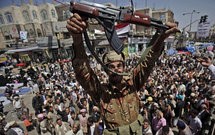 Soon after its formal establishment in 1932, Saudi Arabia invaded Yemen and absorbed the Yemeni provinces of Asir and Najran, in 1934. Since then, Saudi Arabia has tried to influence internal political dynamics by using a ‘carrots and sticks’ policy to ensure that unfriendly regimes did not come to power in Yemen, but with limited success. For these reasons Yemenis have not been well disposed towards Saudi Arabia.
Soon after its formal establishment in 1932, Saudi Arabia invaded Yemen and absorbed the Yemeni provinces of Asir and Najran, in 1934. Since then, Saudi Arabia has tried to influence internal political dynamics by using a ‘carrots and sticks’ policy to ensure that unfriendly regimes did not come to power in Yemen, but with limited success. For these reasons Yemenis have not been well disposed towards Saudi Arabia.
Except for intermittent periods of relative ‘stability’, from 1962 onwards, Yemen has witnessed continual internal armed conflicts between regional and tribal groupings. Ali Abdullah Saleh, a Zaidi Shia himself, was president of North Yemen from 1978 to 1990 and of united Yemen till 2012. Major protests against his autocratic rule started in the mid-1990s. The most powerful amongst them was by the Ansar Allah, under the leadership of Hussein al Houthi, from the Saada region in the north, but there were no sectarian motives behind this. This led to a concerted military campaign against the Zaidi Shia grouping, during which Hussein al Houthi was killed in September 2004, even as Saleh was dubbed a puppet of the Americans and yet another ‘civil war’ in Yemen began.
Saleh’s inability to control the burgeoning mass demonstrations in Yemen, which were part of the so-called Arab Spring unrest, led to him being forced to step down by the GCC countries in 2012; adept at switching alliances, Saleh opportunistically allied with the Houthis in 2014 in an effort to recapture power. Having headed the army and the country for so long, Saleh enjoys a considerable support within the army (even though it is a predominantly Sunni army), and particularly amongst the powerful Republican Guard. This support has contributed particularly significantly to the Houthis taking control of most of the country including almost all its main cities and ports in just a few months. The president and his cabinet were arrested.
Having escaped, the President of Yemen, Abd Rabbu Mansour al Hadi, a southerner, and previously a vice president under Saleh, first fled to Aden and after the presidential palace came under attack there, fled to Saudi Arabia. Al Hadi has no support base in north Yemen and little real support even in southern Yemen, except in Aden. Meanwhile the former supporters of al Qaeda in the Arabian Peninsula (in Yemen) who have recently allied themselves with the Islamic State, have steadily been expanding its control of major areas of southern Yemen.
All this has led to Saudi Arabia abandoning its traditional cautious, deliberate, low key diplomacy and adopting a surprisingly muscular approach, apparently at the behest of the very young and completely inexperienced new Saudi Defence Minister, the youngest son of King Salman, Mohammad bin Salman Al Saud. Incredibly, in a matter of days, Saudi Arabia successfully forged a grand Sunni alliance and launched ‘Operation Decisive Storm’ involving extensive air strikes against Houthi and Saleh forces in and around Sana’a, Taiz, Hodeidah and even Aden in the past week, but has been unable to dent the Houthi/Saleh dominance.
A particularly notable feature is the large military commitments made by the members of this coalition, with Saudi Arabia contributing 100 fighter jets, 150,000 soldiers, and some naval units; Bahrain and Kuwait deploying 15 fighter jets each; Qatar contributing 10 jets; and Jordan contributing 6. Even Sudan has promised 3 jets. Egypt is deploying unspecified naval and air force units, and ground forces will be deployed “if necessary.” Concerted efforts to persuade Pakistan to join are being led by King Salman himself. Turkey is being strongly wooed too. This underscores Saudi Arabia’s alarm about developments in Yemen.
Frenetic Saudi rhetoric notwithstanding, there is little credible evidence of Iran having provided large enough consignments of weapons, to make a tangible difference, to the Houthis. But, Iran has now made very significant gains in Yemen: direct flights between Tehran and Sana’a started in March; with several ports now being under Houthi control, theoretical possibilities of Iranian weapons supplies to Yemen have opened up. This will inevitably happen if needed. Iran has already signed several agreements with the Houthi authorities to supply Iranian oil, help in construction of power plants, modernisation of strategic ports, etc.
Thus, Iran has acquired credible locus standii and will now inevitably be an active player in the processes to determine Yemen’s future, particularly now that the nuclear deal has been signed. The issue of the ‘lost provinces’ may well be reopened.
Clearly, the war cannot be won through air strikes alone. Given that Saudi troops had performed particularly poorly against the then much weaker and less organised Houthis in 2009-2010, and have no real combat experience, they are hardly likely to do any better this time, fighting against battle-hardened Yemenis in their own terrain. A military victory is unimaginable. A semblance of peace, the normal situation in Yemen, can only be re-established through negotiations mainly between the parties directly concerned – Iran and Saudi Arabia under US auspices sitting down with the Houthis.
There is very little prospect of a Saudi-friendly government emerging as the end result of such negotiations. Thus, the unfolding events in Yemen are likely to prove another and particularly major strategic setback for Saudi Arabia. Meanwhile, Yemen is likely to remain embroiled in violent civil strife for some years to come.
By Special Arrangement with Institute of Peace and Conflict Studies (http://www.ipcs.org)